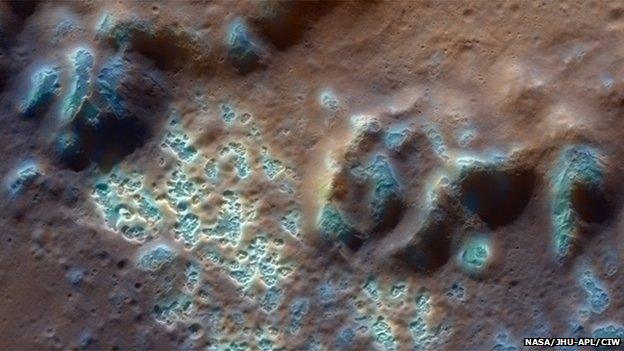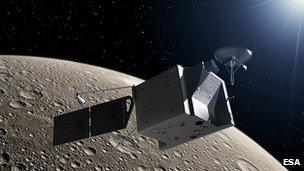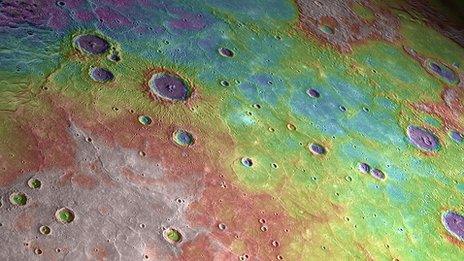Mercury shows off its colourful side
- Published
Messenger compiled this coloured map of Mercury during its first year in orbit
Scientists working on Nasa's Messenger probe to Mercury have shown off a stunning new colour map of the planet.
It comprises thousands of images acquired by the spacecraft during its first year in orbit.
This is not how we would see Mercury, which would look like a dull, brownish-grey globe to our eyes.
Rather, the map represents an exaggerated view of the planet that is intended to highlight variations in the composition of its rock.
"Messenger's camera has filters that go from the blue to the near-infrared of the spectrum, and we are able to use computer processing to enhance the very subtle but real colour differences that are present on Mercury's surface," explained Dr David Blewett from the Johns Hopkins University Applied Physics Lab., external

Dr Blewett and his colleagues are in the process of asking for a mission extension
"The areas that you see that are orange - those are volcanic plains. There are some areas that are deep blue that are richer in an opaque mineral which is somewhat mysterious - we don't really know what that is yet.
"And then you see beautiful light-blue streaks across Mercury's surface. Those are crater rays formed in impacts when fresh, ground-up rock is strewn across the surface of the planet," the mission scientist told BBC News.
Dr Blewett displayed the map here in Boston at the annual meeting of the American Association for the Advancement of Science (AAAS), external.

Messenger has found hollowed out surface features that indicate the loss of volatile material
He was giving a sneak preview of the data that is about to be deposited in Nasa's planetary archive.
This will include a black-and-white, or monochrome, map of the entire surface of Mercury at a resolution of 200m per pixel (the colour map has a resolution of 1km per pixel and is just short of 100% coverage).
The mission so far has been a triumph, which ought to make the current request to Nasa management for an operational extension a very easy case to make.
Messenger's observations have thrown up many surprises and challenged a lot of assumptions.
The probe has revealed Mercury's rich volcanic history. It has confirmed the existence of great lava plains, but also uncovered evidence for explosive volcanism.
We know now, too, that the planet has ice in shadowed craters. "It's got polar ice caps. Who'd have thought that?" said Dr Blewett.
In addition, the probe's instruments have detected relatively high abundances of sulphur and potassium in surface materials.
These are volatile elements that should not really be present on such a scale on a planet that orbits so close to the Sun with its searing heat.
But these elements may help explain many puzzles, like the nature of those opaque terrains. These could get their dark hue from the presence of sulphides.
A fly around one of the Mercury "hollows"
The compounds could also lie behind the intriguing "hollows" that pockmark great swathes of Mercury's surface.
Shallow with irregular shapes, the depressions often have bright halos and bright interiors. When scientists look around the Solar System for similar phenomena, the best comparison would appear to be the depressions that form in the carbon dioxide ice at the poles of Mars.
Those features are thought to arise when the CO2 ice sublimates away - that is, when it transforms directly from a solid state to a gaseous state.

Artist's impression: The Europeans and the Japanese are set to arrive in 2022
"Well, Mercury's surface isn't made of ice - it's scorching hot next to the Sun. But it seems that there is some sort of sublimation-like loss in the solid, silicate rocks that is causing these hollows to initiate and enlarge.
"It may be that a combination of high temperatures and what's called severe space weathering destroys sulphide minerals in the rocks, causing them to crumble and open up a depression."
Messenger is in great shape should Nasa management agree to a mission extension. The probe is thought to have enough fuel to operate until 2015.
And by then, new spacecraft will be on their way to Mercury. Under a joint venture known as BepiColombo, Europe and Japan are sending two satellites that should arrive at the innermost world in 2022.
Jonathan.Amos-INTERNET@bbc.co.uk and follow me on Twitter: @BBCAmos, external
- Published20 November 2012
- Published30 November 2012

- Published21 March 2012

- Published16 June 2011
